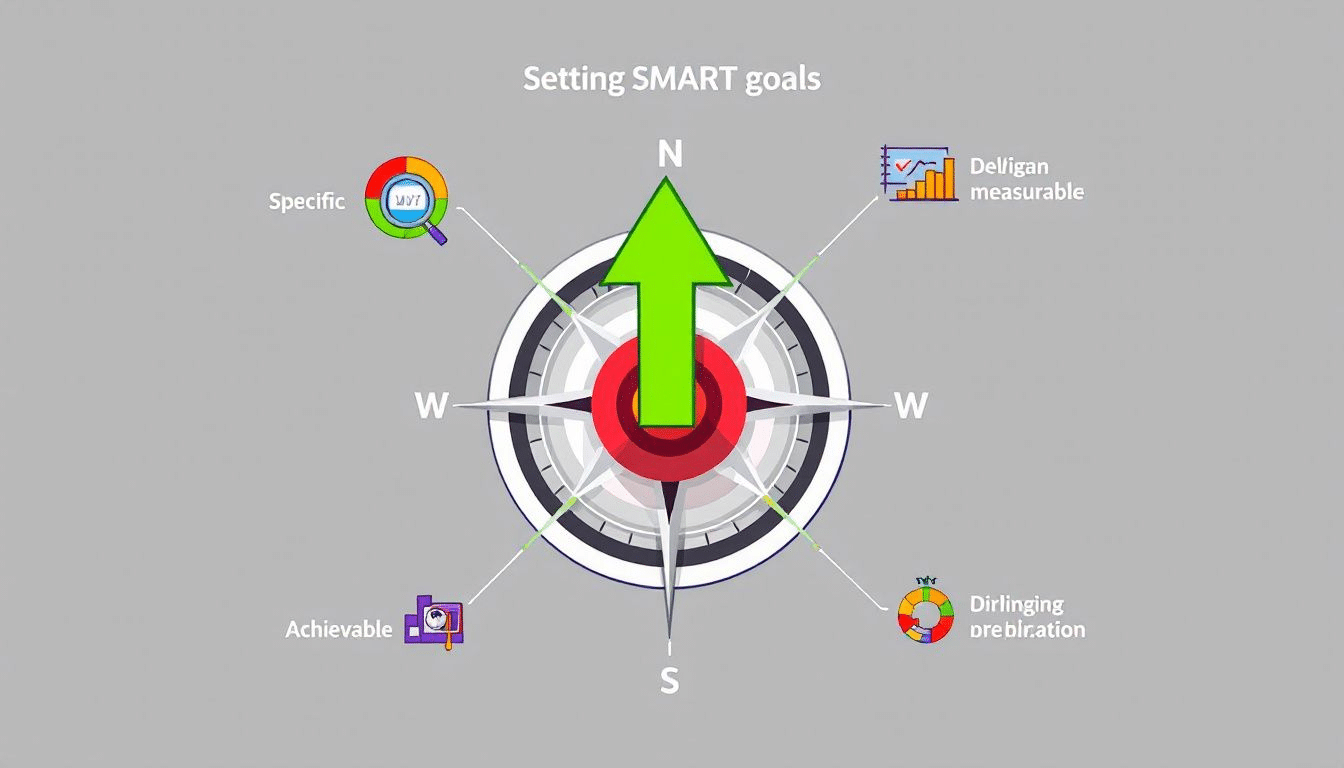The purpose of SMART goals is to create a structured approach to goal setting that ensures clarity and focus. By being Specific, Measurable, Achievable, Relevant, and Time-bound, SMART goals help you define and reach your objectives more effectively. This article will explain how SMART goals work and how you can use them to achieve success.
Key Takeaways
SMART goals provide a clear framework for setting objectives that are Specific, Measurable, Achievable, Relevant, and Time-bound, enhancing clarity and focus.
Establishing SMART goals increases motivation and accountability, leading to a higher likelihood of success and personal growth.
Regular reviews and adjustments of SMART goals are essential to maintain their relevance, prevent rigidity, and encourage creativity in achieving long-term visions.
Understanding the Purpose of SMART Goals: A Guide to Achieving Success

SMART goals aim to achieve meaningful and impactful outcomes by providing clarity and direction. Specific, measurable smart goals, achievable, relevant, and time-bound defined objectives help define what needs to be done and who is responsible, eliminating ambiguity and enabling focused, efficient efforts.
SMART goals focus on setting the right smart objective, ensuring they are achievable to maintain motivation and avoid frustration. This framework guides effective goal setting process by making sure every objective is clear, realistic, and time-bound.
Introduction
SMART goals are a structured approach to goal setting that can transform the way we pursue our ambitions. Originating from the influential ideas of Peter Drucker, the SMART acronym stands for Specific, Measurable, Achievable, Relevant, and Time-Bound. This method provides a clear and concise framework for setting and achieving objectives, whether in a business setting or personal life.
SMART goals were designed to enhance clarity and focus in goal setting. Breaking down goals into five smart components ensures they are clear and attainable within a specified time frame, aligning resources and efforts toward achieving the ultimate objective.
This guide provides a comprehensive overview of SMART goals, from their definition and benefits to how to create your own. It equips you with the tools to set and achieve objectives effectively, whether for team performance or personal milestones.
Defining SMART Goals
SMART goals stand for Specific, Measurable, Achievable, Relevant, and Time-bound. This framework sets clear, realistic, and trackable objectives. Here’s a breakdown of each component:
Specific: Goals should be clear and specific, answering the questions of what needs to be accomplished, who is involved, and what resources are needed. Specificity helps clarify what needs to be done and eliminates ambiguity.
Measurable: Goals need to be quantifiable to track progress and determine when they are achieved. Measurable criteria allow for clear assessments of success and help maintain motivation.
Achievable: Goals should be realistic and attainable within the given resources and capabilities. They should challenge you but remain possible to achieve, preventing frustration and maintaining motivation.
Relevant: Goals must align with broader business aims and personal values to be meaningful. Ensuring relevance helps in prioritizing efforts and resources effectively.
Time-bound: Setting a deadline for goals helps maintain focus and urgency. Time-related parameters ensure that teams stay on track and measure success over defined periods.
The SMART framework allows individuals and organizations to set clear, realistic, and achievable objectives, enhancing motivation and accountability with a definitive success roadmap.
Why SMART Goals Matter

SMART goals provide clarity and direction, eliminating ambiguity and ensuring objectives are attainable within a set timeframe. This helps teams align their understanding of success and monitor progress effectively.
Knowing the ‘why’ behind goals is crucial for maintaining focus and prioritizing efforts. When individuals understand the importance of their goals, they stay motivated and committed. Research shows that people who write down their goals are about 42% more likely to achieve them, underscoring the effectiveness of structured goal setting.
Many successful individuals attribute their achievements to using SMART goals in their planning. Employees who regularly review and update their SMART goals are 30% more likely to progress in their careers. This structured approach enhances both personal and professional growth and contributes to overall business success.
Enhancing Focus with SMART Goals
SMART goals enhance focus by prioritizing tasks that align with broader objectives, making efforts more directed and purposeful. Individuals who set specific, measurable goals are significantly more likely to achieve their objectives, with studies showing up to a 90% success rate compared to those without clear smarter goals.
Connecting goals with daily work ensures motivation, focus, and alignment. Deadlines create urgency and help individuals and teams stay on track. Setting SMART goals maintains clear focus on tasks and their execution.
Measuring Progress Effectively
Measuring progress is crucial for achieving SMART goals. Goals are measurable if they are trackable and quantifiable, enabling clear assessments of success. Measurable goals make it easier to track achievements and maintain motivation.
Regular check-ins are essential for monitoring progress and making necessary adjustments. Setting milestones within a timeframe provides motivation and clarity, helping identify when course corrections are needed.
Clear success criteria establish expectations and responsibilities. Reliable metrics enable effective evaluation of SMART goals’ progress, ensuring performance aligns with objectives.
Realistic and Achievable Objectives
Realistic and achievable goals are crucial for maintaining motivation and confidence. Achievable goal should be within the realm of possibility, considering available resources and capabilities. Attainable goals enhance motivation and build confidence, increasing the likelihood of achievement.
Aligning goals with personal values and broader organizational objectives increases relevance and attainability. Realistic deadlines prevent achieving goals from becoming unrealistic ambitions, ensuring a balanced approach to challenges and minimizing stress.
Relevance in Goal Setting
The ‘Relevant’ component of SMART goals highlights the alignment with personal values and broader objectives. Relevant goals should be worthwhile and timely, ensuring meaningful achievements.
Aligning goals with personal skills and organizational objectives enhances motivation and focus. Failing to align goals with organizational objectives reduces relevance, making it harder to stay committed and motivated.
The SMART framework helps identify misalignments between priorities and available resources when setting goals.
The Role of Deadlines
Deadlines create urgency and prevent procrastination, crucial for successful goal completion. Time-bound criteria in time bound smart goals ensure clarity on when goals are expected to be met, helping maintain focus and direction. Clear timeframes for task start and finish help teams stay on track and measure success.
For example, aiming to grow monthly users of a mobile application by 1,000 by the end of a specified quarter creates urgency and directs efforts toward achieving the target date within the designated period.
Benefits of SMART Goals

Clearly defined goals improve success likelihood by eliminating ambiguity and ensuring objectives are realistic. SMART goals facilitate motivation by setting achievable and measurable objectives with clear benchmarks for progress, maintaining focus.
Research shows that SMART goals can boost productivity by up to 25% among employees when clear and challenging objectives are set. Celebrating small successes encourages continued effort and maintains motivation.
Time limits help maintain progress and ensure tasks retain priority and direction. Clear deadlines enhance team cohesion and accountability, aligning efforts towards common goals and boosting business success.
Common Pitfalls and How to Avoid Them
While SMART goals are effective, they can be inflexible and stifle creativity. Potential downsides include oversimplification, short-term focus, and the hindrance of creativity, which can discourage visionary planning and limit long-term effectiveness.
Strict guidelines in SMART goal setting may limit unexpected ideas and hinder creative solutions. Although employees engaging in SMART goal-setting often experience lower stress and anxiety, common mistakes can compromise this benefit. Regularly reviewing and adjusting goals ensures they remain attainable as circumstances change, avoiding irrelevant target settings.
Teams may find that goals quickly fall off track, underscoring the need for flexibility and regular evaluation. Avoiding common pitfalls maintains the effectiveness of SMART goals while fostering creativity and long-term vision.
Examples of Effective SMART Goals
Effective SMART goals illustrate their application in various contexts. For example, reducing average customer support response time by 50% over three months by optimizing processes and training staff is clear and measurable. Achieving a 95% on-time project completion rate within a year by improving project management and communication is another SMART criteria-aligned example.
Increasing brand awareness by 25% in four months through a focused social media campaign shows the relevance and achievability of SMART goals. Launching a company-wide challenge to generate at least 10 viable new product ideas in six months fosters innovation and aligns with broader business objectives.
Enhancing customer satisfaction ratings from 75% to over 90% through weekly surveys and improvements based on feedback is a practical SMART goal application for improving service quality. These examples demonstrate how SMART goals can be tailored to various needs, driving success and achieving desired outcomes.
Steps to Create Your Own SMART Goals
Creating SMART goals involves several steps. First, define what you want to accomplish to set a clear direction. Ensure goals are Specific, Measurable, Achievable, Relevant, and Time-bound. Breaking down objectives into manageable components helps track and achieve them effectively.
Determine how you’ll measure success after defining your goal to maintain clarity on progress. Establishing SMART parameters ensures objectives are attainable within a timeframe and facilitates progress tracking. Breaking down goals into smaller steps allows for daily tracking and action planning, making the process more manageable.
Incorporating milestones within deadlines can facilitate feedback and adjustments during project execution. Following these steps helps you set and achieve SMART goals, ensuring clarity, relevance, and success in your endeavors.
Summary
In summary, SMART goals provide a structured and effective approach to goal setting, ensuring that objectives are specific, measurable, achievable, relevant, and time-bound. By eliminating ambiguity and providing clear benchmarks for progress, SMART goals enhance motivation, focus, and productivity. Whether in a business context or for personal development, applying the SMART framework can significantly increase the likelihood of success.
As you embark on your journey of setting and achieving goals, remember to regularly review and adjust your objectives to remain aligned with changing circumstances. By setting SMART goals, you can transform your ambitions into reality and achieve meaningful success. Start today and experience the transformative power of SMART goals in your life and work.
FAQ
What does SMART stand for?
SMART stands for Specific, Measurable, Achievable, Relevant, and Time-bound, and understanding this framework can help you set effective goals and achieve your dreams!
Why are SMART goals important?
SMART goals are essential because they bring clarity and direction to your objectives, empowering you to track your progress and stay motivated. Embrace the SMART framework to unlock your full potential!
How do SMART goals enhance focus?
SMART goals enhance focus by helping you prioritize tasks that align with your main objectives, ensuring you stay on track and motivated. By setting clear deadlines, you create a sense of urgency that drives you towards achieving your goals.
What are some common pitfalls of SMART goals?
To ensure your SMART goals truly work for you, be aware of common pitfalls like inflexibility and short-term focus, which can stifle your creativity. Regularly review and adjust your goals to keep them dynamic and inspiring!
Can you give an example of a SMART goal?
A great example of a SMART goal is to reduce customer support response time by 50% within three months through improved processes and staff training. Setting such a specific and time-bound target can lead to significant improvements in service!






